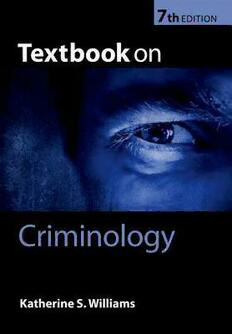
Textbook on Criminology PDF
Preview Textbook on Criminology
Textbook on Criminology This page intentionally left blank Textbook on Criminology Seventh edition Katherine S. Williams Senior Lecturer in Criminology, Aberystwyth University 1 3 Great Clarendon Street, Oxford, OX2 6DP, United Kingdom Oxford University Press is a department of the University of Oxford. It furthers the University’s objective of excellence in research, scholarship, and education by publishing worldwide. Oxford is a registered trade mark of Oxford University Press in the UK and in certain other countries © Katherine S. Williams 2012 The moral rights of the author have been asserted Fourth Edition copyright 2001 Fifth Edition copyright 2004 Sixth Edition copyright 2008 Impression: 1 All rights reserved. No part of this publication may be reproduced, stored in a retrieval system, or transmitted, in any form or by any means, without the prior permission in writing of Oxford University Press, or as expressly permitted by law, by licence or under terms agreed with the appropriate reprographics rights organization. Enquiries concerning reproduction outside the scope of the above should be sent to the Rights Department, Oxford University Press, at the address above You must not circulate this work in any other form and you must impose this same condition on any acquirer Public sector information reproduced under Open Government Licence v1.0 (http://www.nationalarchives.gov.uk/doc/open-government-licence/ open-government-licence.htm) Crown Copyright material reproduced with the permission of the Controller, HMSO (under the terms of the Click Use licence) British Library Cataloguing in Publication Data Data available Library of Congress Cataloging in Publication Data Data available ISBN 978–0–19–959270–8 Printed in Great Britain by Ashford Colour Press, Gosport, Hampshire Links to third party websites are provided by Oxford in good faith and for information only. Oxford disclaims any responsibility for the materials contained in any third party website referenced in this work. ACKNOWLEDGEMENTS Thanks and apologies to Alex, Siân, Dewi and Mair who kept me sane. For LJ NEW TO THIS EDITION The seventh edition of Textbook on Criminology has been thoroughly revised to re- fl ect all recent developments in the criminological theory, policy, practice and law, since the publication of the sixth edition, including: • a new chapter introducing the reader to the study of theory and, in particular, how to approach criminological theory which will act as useful preliminary material for the rest of the text; • expanded consideration of critical criminology; and • a new section introducing the reader to cultural criminology. OUTLINE CONTENTS Introduction 1 1 What is criminological theory? 7 2 Defi nitions, terminology and the criminal process 19 3 Public conceptions and misconceptions of crime 53 4 The extent of crime: a comparison of offi cial and unoffi cial calculations 81 5 Victims, survivors and victimology 103 6 Infl uences of physical factors and genetics on criminality 142 7 Infl uences of biochemical factors and of the central and autonomic nervous systems on criminality 164 8 Psychological theories of criminality 185 9 Mental disorder (psychopathology) and criminality 232 10 Intelligence and learning 265 11 The sociology of criminality 301 12 Anomie, strain and juvenile subculture 341 13 Control theories 372 14 Labelling, phenomenology and ethnomethodology 410 15 Critical criminology: confl ict, radical and cultural criminologies 443 16 Criminology and realism 472 17 Positivist explanations of female criminality 501 18 Feminist theories 523 19 Terrorism and State violence 553 20 Governance, risk and globalisation theories 584 Envoi 612 Useful websites 616 Name index 623 Subject index 637 This page intentionally left blank DETAILED CONTENTS Acknowledgements v Introduction 1 Questions 6 1 What is criminological theory? 7 1.1 Introduction to criminological 1.3.2 Positivism and explanations 16 theory 7 Revision box 17 1.2 Classical criminology 9 Suggested reading 17 1.2.1 What is classical criminology? 9 Questions 17 1.2.2 The impact of classicism 12 References 18 1.2.3 Neo-classical criminology 13 1.3 Positivist criminology 14 1.3.1 Positivism and method 15 2 Defi nitions, terminology and the criminal process 19 2.1 Introduction 19 2.8 Terminology and classifi cation 47 2.2 The judicial process 19 2.8.1 Felonies and misdemeanours 47 2.8.2 Arrestable and non-arrestable 2.3 Formal sources of criminal law 20 offences 47 2.4 Underlying infl uences 21 2.8.3 Indictable and summary 2.5 Defi ning a crime 23 offences 47 2.5.1 Formal legalistic defi nition 23 2.9 Appeals 48 2.5.2 Basic elements of most crimes 24 2.10 Limits of prosecution 49 2.5.3 What actions are criminalised? 26 2.11 Evidence 50 2.5.4 Particular cases 32 2.12 Punishment 50 2.5.5 Defi nitions and usage 37 Questions 51 2.6 Enforcement of criminal laws 39 References 51 2.7 The criminal 46 3 Public conceptions and misconceptions of crime 53 3.1 Introduction 53 3.4.3 Corporate crime or organisational crime 68 3.2 Popular and media perceptions of crime 54 3.5 Media hype and folk devils 73 3.3 Effects of media on public Suggested reading 76 perceptions of crime 60 Questions 77 3.4 Two less visible areas of crime 64 Useful websites 77 3.4.1 Introduction 64 References 77 3.4.2 White-collar crime 65
